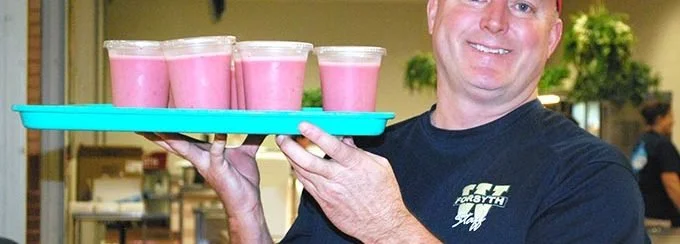School Breakfast Success Stories (2017)
John Edward Jeffries (J.E.J.) Moore Middle School (Disputanta, Virginia)
Through joint outreach and funding efforts with SUDIA and the Virginia No Kid Hungry program, JEJ Moore Middle School began serving Grab N’ Go Breakfast on March 1, 2016, using a mobile serving cart, insulated cooler bags for milk, and a mobile point-of-service kiosk. To encourage breakfast participation and milk consumption, SUDIA and the school hosted a promotion during National Nutrition Month (March 2016). If students selected nutrient-rich milk at breakfast, their names were put into a drawing to win Fuel Up to Play 60 earbuds. Three winners were selected for three weeks. As a result of school efforts, school breakfast participation increased 176 percent (2,073 to 3,643 meals) from March 2015 to March 2016 and 221 percent (1,975 to 4,375 meals) from April 2015 to 2016.
Forsyth County Schools (Cumming, Georgia)
In the 2014-15 school year, Forsyth County Schools offered all of its schools the option to start a smoothie program as an incentive to increase student breakfast participation. By the end of the 2015-16 school year, 23 out of the 30 schools in Forsyth County were offering smoothies as either a reimbursable breakfast meal or à la carte lunch item. To assist their efforts, SUDIA provided industrial blenders to eight schools between 2014 and 2016 (the county provided blenders to the remaining schools). SUDIA also provided Smooth and Smart™ promotion kits to the funded schools. All the schools had a marketing plan and many of the schools used social media platforms to advertise their smoothies. The school nutrition department also hosted an expo for parents to introduce the new smoothie program. The program is still going strong, with some schools in the district selling as many as 500 smoothies a day. Schools offer seasonal flavors throughout the year, such as “Harvest Morning” smoothies using apples with brown sugar and cinnamon and “Leprechaun” smoothies using spinach and pineapple.
East Baton Rouge Parish Public Schools (Baton Rouge, Louisiana)
East Baton Rouge Parish Public Schools’ child nutrition program increased the number of breakfasts served by more than 2,000 per day with the implementation of a Breakfast in the Classroom (BIC) program. Equipment provided by SUDIA in 2014 helped get the program going. Since then, 29 schools in the district have adopted Breakfast in the Classroom. Between 2014 and 2015, student breakfast participation in the district increased 19 percent and milk sales increased 39 percent. Each school that has joined the BIC program has its own success story to tell. School officials report discipline issues have decreased and attendance has improved at some of the BIC implementation sites. Decreased visits to the school nurse have been reported and more interaction and trust between students and teachers, as the program allows more instructional time with the teacher than traditional cafeteria breakfast. Despite the displacement of many of the district’s students in 2016 due to flooding, Breakfast in the Classroom remains a mainstay at many district schools.
West Point Public Schools (West Point, Virginia)
During the 2015-16 school year, West Point Public Schools’ nutrition program worked with SUDIA to increase breakfast participation by introducing reimbursable meal deal yogurt and milk smoothies as a new breakfast menu option. Schools saw a slight increase in breakfast participation, but there was room to grow. Working with their local SUDIA representative, the school system applied for a Fuel Up to Play 60 School Nutrition Equipment Grant to support an alternative breakfast program utilizing breakfast serving carts and wireless payment tablets. The program was launched at West Point’s middle and high schools in October 2016. Just one month prior to the launch, West Point served only 470 breakfasts a month at the middle and high school level. By the end of October, that number went up to 785 breakfasts served. In November, the school system served 1,060 breakfasts a month to middle and high school students, more than doubling the previous year average of 414 breakfasts a month—a 156 percent increase in breakfast participation.








